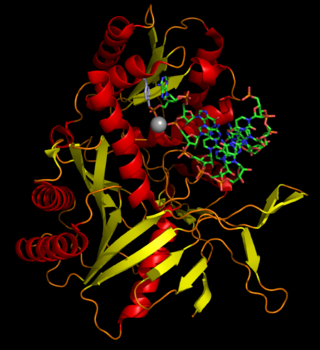Chrysiogenaceae is a family of bacteria.
The Thermoprotei is a class of the Thermoproteota.

Archaeoglobaceae are a family of the Archaeoglobales. All known genera within the Archaeoglobaceae are hyperthermophilic and can be found near undersea hydrothermal vents. Archaeoglobaceae are the only family in the order Archaeoglobales, which is the only order in the class Archaeoglobi.
Thermoplasma is a genus of archaeans. It belongs to the class Thermoplasmata, which thrive in acidic and high-temperature environments. Thermoplasma are facultative anaerobes and respire using sulfur and organic carbon. They do not contain a cell wall but instead contain a unique membrane composed mainly of a tetraether lipoglycan containing atypical archaeal tetraether lipid attached to a glucose- and mannose-containing oligosaccharide. This lipoglycan is presumably responsible for the acid and thermal stability of the Thermoplasma membrane.

In taxonomy, the Thermoplasmata are a class of the Euryarchaeota.

Thermoplasmataceae is a family of archaeans in the order Thermoplasmatales. It contains only one genus, Thermoplasma. All species within Thermoplasmataceae are thermoacidophiles, and they grow at a temperature of 60 °C and pH 2. They were isolated from hydrothermal vents, fumaroles and similar environments.
Picrophilaceae is a family of microbes within the order Thermoplasmatales.

In the taxonomy of microorganisms, the Methanomicrobia are a class of the Euryarchaeota.

Acidilobales are an order of archaea in the class Thermoprotei.

The Desulfurococcales is an order of the Thermoprotei, part of the kingdom Archaea. The order encompasses some genera which are all thermophilic, autotrophs which utilise chemical energy, typically by reducing sulfur compounds using hydrogen. Desulfurococcales cells are either regular or irregular coccus in shape, with forms of either discs or dishes. These cells can be single, in pairs, in short chains, or in aciniform formation.
Methanobacteriales is an order of archaeans in the class Methanobacteria. Species within this order differ from other methanogens in that they can use fewer catabolic substrates and have distinct morphological characteristics, lipid compositions, and RNA sequences. Their cell walls are composed of pseudomurein. Most species are Gram-positive with rod-shaped bodies and some can form long filaments. Most of them use formate to reduce carbon dioxide, but those of the genus Methanosphaera use hydrogen to reduce methanol to methane.
In taxonomy, the Methanococcales are an order of the Methanococci.

The Nitrosopumilales are an order of the Archaea class Nitrososphaeria.

In taxonomy, the Ferroplasmaceae are a family of the Thermoplasmatales.

In taxonomy, the Methanosarcinaceae are a family of the Methanosarcinales.
Methanospirillaceae are a family of microbes within Methanomicrobiales.
The Pyrodictiaceae are a family of disc-shaped anaerobic microorganisms belonging to the order Desulfurococcales, in the domain Archaea. Members of this family are distinguished from the other family (Desulfurococcaceae) in the order Desulfurococcales by having an optimal growth temperature above 100 °C, rather than below 100 °C.
Methanocaldococcus formerly known as Methanococcus is a genus of coccoid methanogen archaea. They are all mesophiles, except the thermophilic M. thermolithotrophicus and the hyperthermophilic M. jannaschii. The latter was discovered at the base of a “white smoker” chimney at 21°N on the East Pacific Rise and it was the first archaean genome to be completely sequenced, revealing many novel and eukaryote-like elements.

In taxonomy, Methanohalophilus is a genus of the Methanosarcinaceae.
In taxonomy, Methanospirillum is a genus of microbes within the family Methanospirillaceae. All its species are methanogenic archaea. The cells are bar-shaped and form filaments. Most produce energy via the reduction of carbon dioxide with hydrogen, but some species can also use formate as a substrate. They are Gram-negative and move using archaella on the sides of the cells. They are strictly anaerobic, and they are found in wetland soil and anaerobic water treatment systems.









